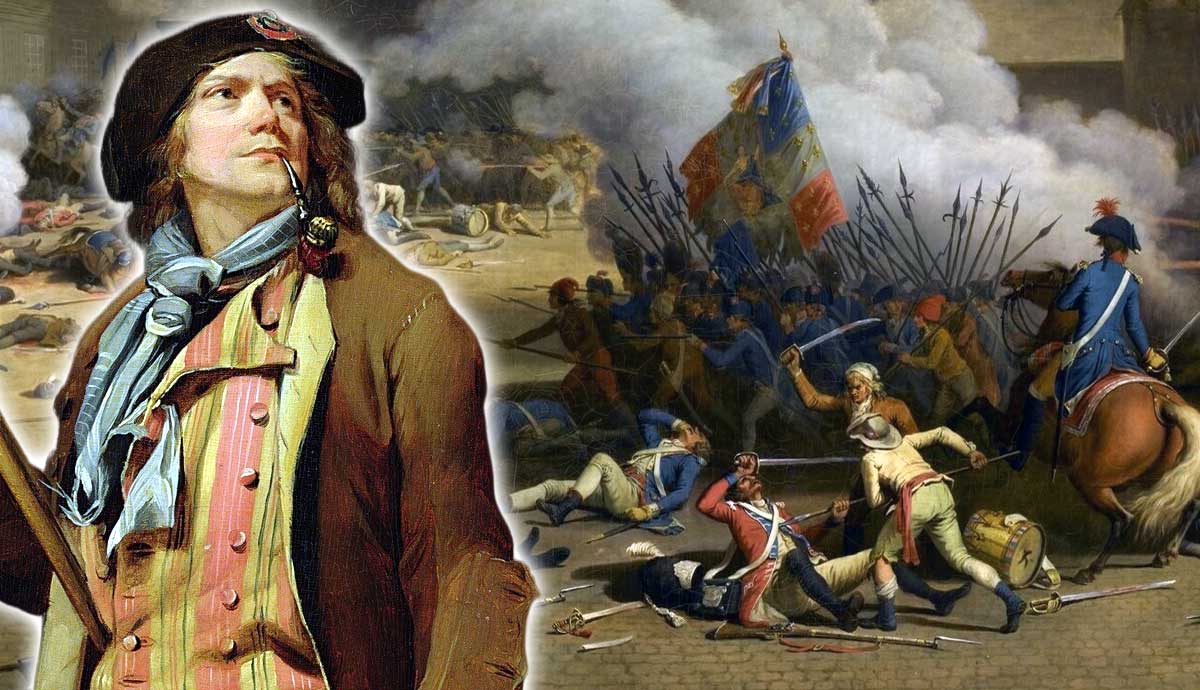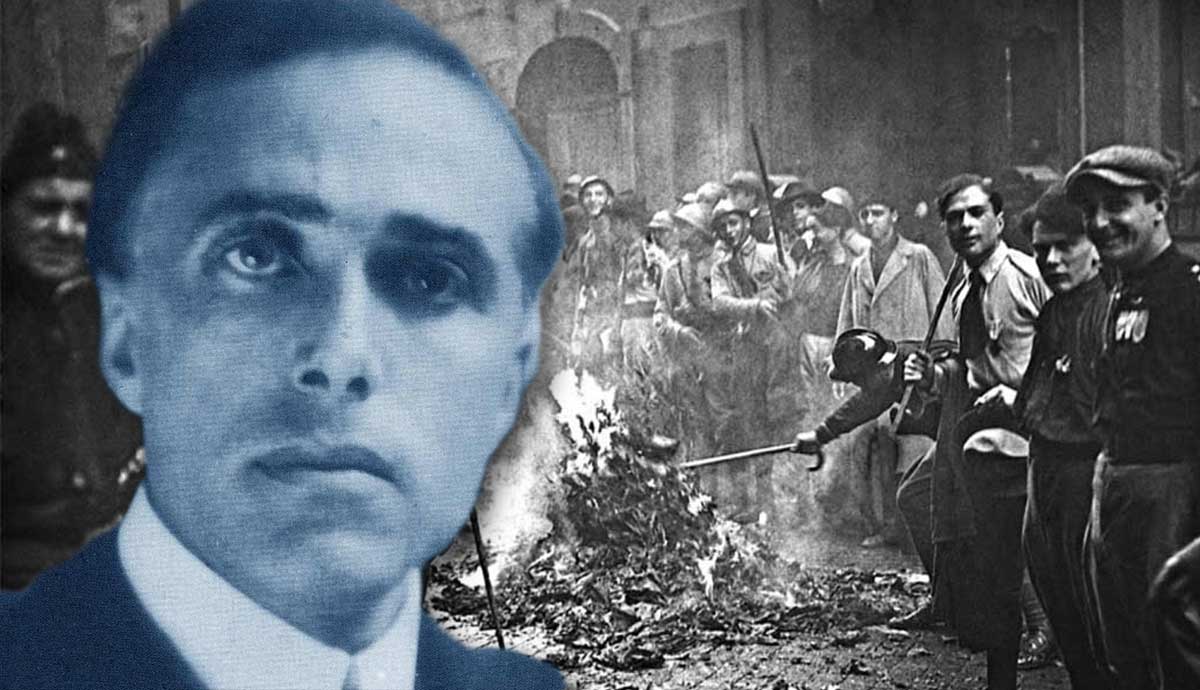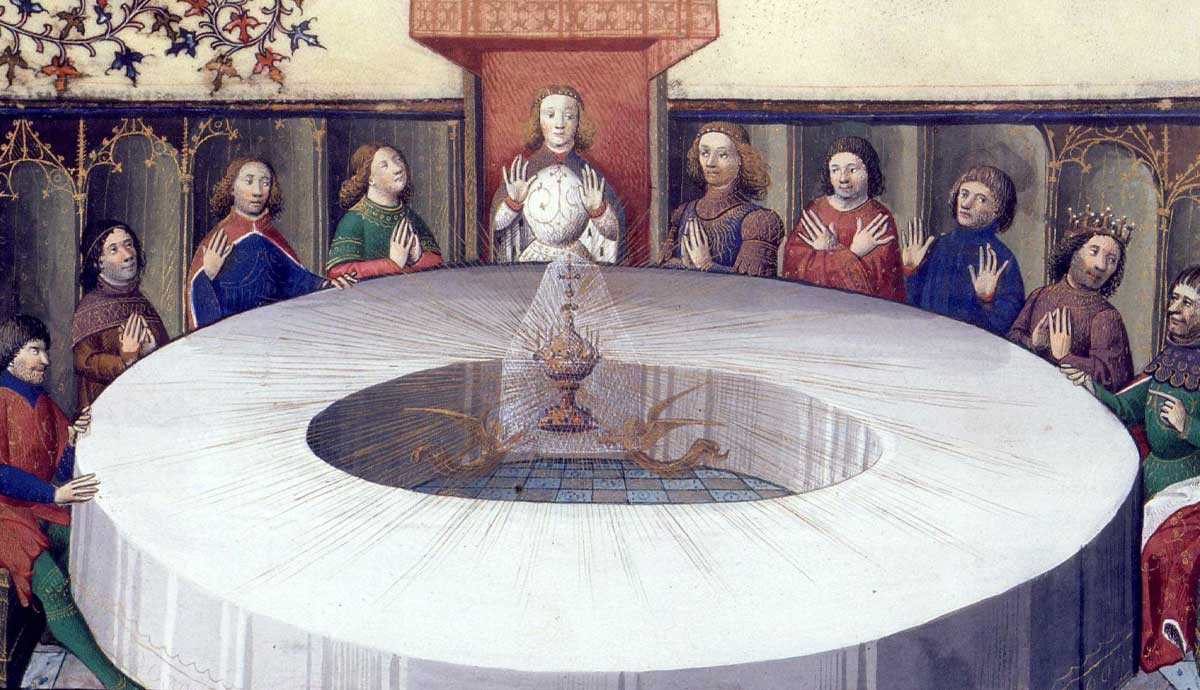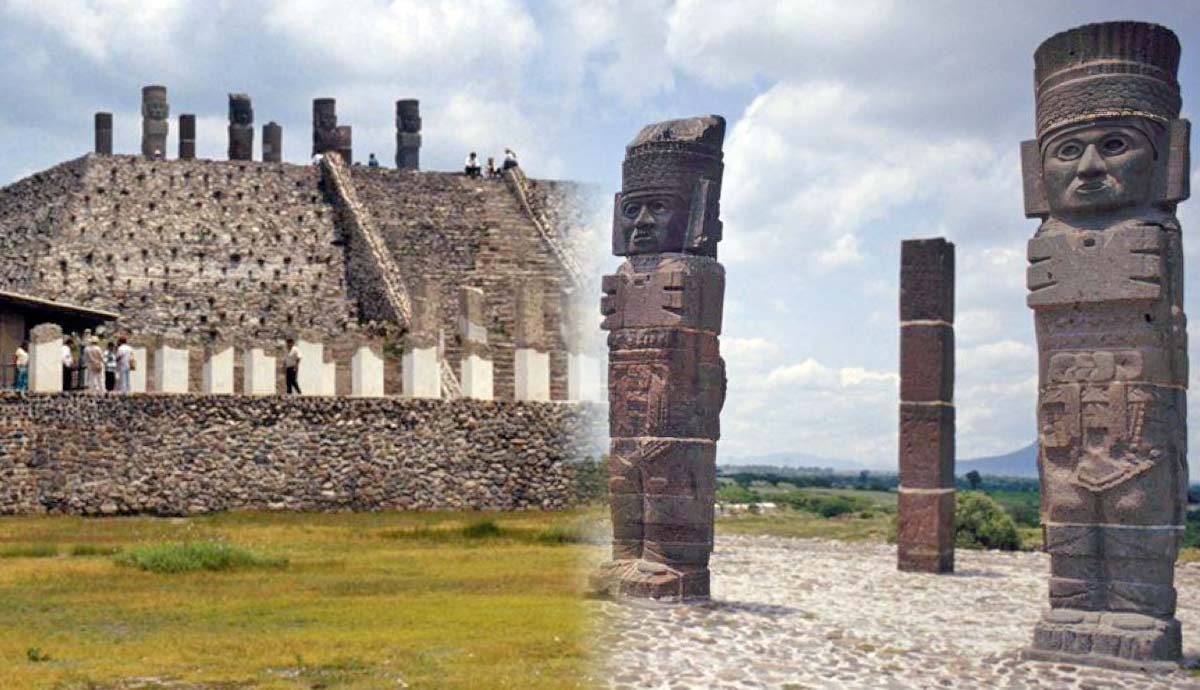
With their long trousers, short jacket, and red cap of liberty, the sans-culottes are one of the more distinctive figures commonly associated with the French Revolution. From 1792, the term sans-culottes referred to the most radical supporters of the revolution, demanding political, economic, and social equality. Among the most passionate defenders of the revolutionary ideals during the Reign of Terror, their political influence decreased after Maximilien Robespierre became wary of their radicalism.
Origins of the Sans-Culottes

On June 20, 1792, a crowd of Parisians broke into the Tuileries Palace, where the French royal family was being held after their arrest the year before. Once inside, the protesters forced King Louis XVI to wear the Phrygian red cap of liberty, a symbol of the French Revolution.
According to the eyewitness account by English doctor and travel writer John Moore, the June 20 protest had begun with a procession starting from the site of the former Bastille fortress (famously demolished on July 14, 1789). Headed by the National Guard of the faubourg Saint-Antoine, the crowd carried anti-royal banners. “Tremble tyrants, or be just and respect the liberty of the people,” read one of the slogans.
“Among other ingenious emblems,” Moore recalled, “a pair of old black breeches were carried on a pole, with this comfortable inscription, Libres—et sans-culottes (Free—and without breeches).” In the following months, the word sans-culottes began to spread through Paris and France, and the sans-culottes became a common sight in popular protests and assemblies. But what does “sans-culottes” actually mean?
As John Moore accurately translated, the French term “sans-culottes” literally means “without breeches.” In late 18th century France, fashion was a strong indicator of social status, and appearance was seen as a reflection of a person’s inner character. The wealthy elite, whose members could afford fine fabrics and expensive tailoring, usually wore well-fitting suits comprising a coat, waistcoat, and silk knee-length breeches.

While the lower classes, who needed looser clothes to carry out their mostly manual jobs, also donned coats and waistcoats (albeit made of less expensive fabrics), they replaced the silk breeches with the pantalons (long trousers). Maximilien Robespierre would later distinguish between the “golden breeches” and the sans-culottes. During the initial years of the French Revolution, the crowd animating the streets of Paris and gathering in the many assemblies transformed these modest clothes into a badge of pride and a visual representation of their political stance.
“Their working-class trousers served as shorthand for their radical pride in their humble origins and egalitarian values,” remarks fashion historian Kimberly Chrisman-Campbell. French writer Louis-Sébastien Mercier (1740-1814), commenting on the June 20, 1792, revolt in Paris, wrote: “The aristocracy has given patriots the name of sans-culottes and they in turn, identifying themselves with the Greeks and Romans, all peoples who wore no breeches, have put a pair of breeches on parade, as if to tell… that without us, you wouldn’t have any breeches. The weapons used by miserable aristocrats whose sole strength is a play on words ought to be used to combat them.”

Historian Michael Sonenscher, in his 2008 Sans-Culottes: An Eighteenth-Century Emblem in the French Revolution, has traced the origins of the word “sans-culottes” to the early 18th-century salon culture in France, where women matrons used to gift their proteges a pair of breeches (culottes) on New Year’s Day. As wearing these fashion items signified an author’s financial security and literary status, writers without a wealthy patron who could give them a pair of the sought-after breeches were jokingly called sans culottes (without hyphen). According to Sonenscher, this salon society joke was also about “a way of thinking about civility, politeness, and morality that resonated to early-modern conceptions of honour, honesty, and honnêteté [honesty].”
The French Revolution challenged the existing link between culture and morality and wealth and justice. Indeed, the pantalons-wearing crowd of the Revolution rejected the political and social system of the Ancien Régime, claiming active political participation for the lower classes, social equality, and a new set of ideals: liberty, fraternity, and equality.
In the early 1790s, the sans-culottes costume, consisting of a short jacket (carmagnole), wooded shoes (sabots), the red cap of liberty (bonnet rouge), and the pantalons, became one the most popular symbols of the French Revolution.
Who Were the Sans-Culottes?

It is difficult to define the social make-up of the sans-culottes. While it would seem natural to compare them to the working class, the sans-culottes were a far more diversified group. Indeed, scholars cautioned against describing them as a homogeneous social group with a corresponding class consciousness. Famous French historian Jules Michelet simply referred to the Parisian crowd of the French Revolution as “the people.”
In the 1790s, the urban crowd, which made up the rank and files of the sans-culottes, was filled with artisans, small shopkeepers, craftsmen, former servants, wage laborers, and apprentices. On the other hand, wealthier tradesmen, public servants, and professionals from the middle class also donned the signature long trousers and red cap of liberty and took part in protests and riots. During the Reign of Terror, when following the wrong fashion style could lead to arrest, members of the higher classes also identified as sans-culottes.
From November 1790, the newspaper Le Père Duchesne (a popular French comic character) played a key role in turning the sans-culottes into an emblem of the revolution and spreading their ideas. Founded by Jacques Hébert, the main spokesman of the Parisian sans-culottes, Le Père Duchesne often featured a pantalons-wearing man holding a musket and satirical editorials (written by Jacques Hébert himself with extensive use of swear words) against the aristocracy.

The animosity against the Ancien Régime’s elite and the rejection of the feudal system were key elements of the sans-culottes’ identity. “We know who our friends are: those who freed us from the clergy and from the nobility, from feudalism, from tithes, from royalty and from all the plagues that follow in its wake,” declared the members of the sans-culottes society of Beaucaire, a town in southern France.
In the words of an arrested revolutionary, a sans-culotte “is a man who goes everywhere on his own two feet, who has none of the millions you’re all after, no mansions, no lackeys to wait on him…. He is useful, because he knows how to plough a field, handle a forge, a saw, a file, to cover a roof, how to make shoes, and to shed his blood to the last drop to save the Republic.”
What Was the Sans-Culottes’ Role in the French Revolution?

In the first months of 1792, in Paris and several other French provinces, crowds took to the streets to protest against the rise of food prices. The increase was largely due to the depreciation of the assignats, the bonds issued in 1789 by the National Constitutional Assembly during the nationalization of the Roman Catholic Church’s lands in France. The land transfers were aimed at paying off the high public debt and were made mainly through the assignats.
The value of the former church’s land initially guaranteed the value of the bonds. By 1792, however, the assignats, by then the main currency in the country, had fallen to 65% of their former value, leading to widespread inflation.
The sans-culottes protesting the food shortages and higher cost of living aimed their resentment against the wholesalers and merchants accused of hoarding supplies and selling the products at higher prices. Breaking into warehouses and shops, the urban crowds called for the introduction of state-controlled prices. In the following months, the establishment of economic measures aimed at achieving social and economic equality became a key demand of the sans-culottes.

In 1792, the sans-culottes were also crucial in the campaign against the Girondins, the moderate faction of the National Convention calling for a bourgeois republic. In May, after the defection of General Charles Dumouriez to the anti-French coalition (France had declared war against Austria in April), the sans-culottes formed a front with the radical left and the Montagnards, the radical Jacobin deputies at the Convention. Together, they responded to Maximilien Robespierre’s call for an insurrection against the Girondins and for the death penalty for the king.
On August 10, 1792, as fear of an imminent invasion spread throughout France, a mob of Parisians broke into the Tuileries Palace, killing several aristocrats and clergymen held there. In September, the National Convention declared the end of the monarchy. In Paris, the revolutionary Commune was established. Louis XVI, accused of treason, would be guillotined at the Place de la Révolution (present-day Place de la Concorde in central Paris) on January 21, 1793, and his wife, Queen Marie Antoinette, on October 16.
About a year later, in September 1793, following more food riots in all 48 Parisian sections, the Montagnards-controlled National Convention finally introduced the General Maximum, the ceiling of food prices demanded by the sans-culottes.
The Sans-Culottes, Maximilien Robespierre & the Terror

After the expulsion of the Girondins from the National Convention, the Montagnards still had to deal with an increasingly volatile situation, with France’s borders threatened by the anti-French coalition and the government’s stability weakened by the civil war in the Vendée, a region in northwestern France.
In this complex landscape, in April 1793, the revolutionary forces set up the Committee of Public Safety to organize the defense against external and internal enemies and oversee the executive branch. In September, the Committee began to introduce harsher measures against the counterrevolution, with Maximilien Robespierre announcing the creation of a revolutionary militia that would be mainly recruited from the sans-culottes. During the subsequent Reign of Terror, the Committee of Public Safety and the local surveillance committee executed thousands of “enemies of the revolution.”
In June, the Convention had incorporated some key demands of the sans-culottes, such as universal male suffrage, annual elections, popular referendum, and the right to a free education, in a new constitution. However, the charter would never come into effect as it was put on hold until the end of the emergency period.
Meanwhile, the armées révolutionnaires (paramilitary forces mainly composed of sans-culottes) created in French provinces began to arrest all those suspected of being “aristocrats,” an umbrella term that referred to all enemies of the revolution. In May 1793, a local orator described the aristocrats as “all the people with money, all the fat merchants, all the monopolists, law students, bankers, pettifoggers and everyone who has something.”

During the Terror, even behaving in a way that implied hostility toward the ideals of the revolution could lead to arrest. Paul Bonjour, a former valet of a member of the court, was arrested because his manners supposedly revealed “the movements of a heart gangrened with aristocratic sentiments.” In October 1793, the revolutionary committee of the République section justified the arrest of the Duke of Brancas-Céreste stating that “such men are incapable of bringing themselves to the heights of our revolution; their hearts are always full of pride and we shall never forget their former grandeur and their domination over us.”
By the end of 1793, however, the relationship between the sans-culottes and the revolutionary government began to worsen as many left-wing political leaders, including Maximilien Robespierre, grew increasingly wary of the sans-culottes’ radicalism.
The Decline of the Sans-Culottes

As tensions rose and food shortages provoked widespread discontent, on March 4, 1794, Jacques Hébert called for an uprising. Ten days later, the government, supported by the Jacobins, ordered his arrest. After his trial, Hébert was guillotined on March 24 along with a group of his supporters.
Hébert’s execution negatively impacted the sans-culottes, decreasing their political influence. At the same time, the measures against its most radical supporters weakened the stability of the revolutionary government. As internal divisions within the Committee of Public Safety grew, Maximilien Robespierre’s leadership position was challenged by those who accused him of dictatorship. On July 27, 1794 (Thermidor 9 according to the revolutionary calendar), he was overthrown and arrested. He was guillotined the next day.
After Robespierre’s death, the government abolished some of the most radical measures, including the General Maximum. As the National Convention began working on a new constitution, the royalist forces regrouped in the west and southwest of the country, launching the so-called White Terror. In October, a young Napoleon Bonaparte crushed a royalist coup d’état in Paris.
Meanwhile, as the end of the controlled economy led to a surge in prices, the sans-culottes organized their last uprising in the spring of 1795. The protest’s failure marked the end of the political role of the sans-culottes.











